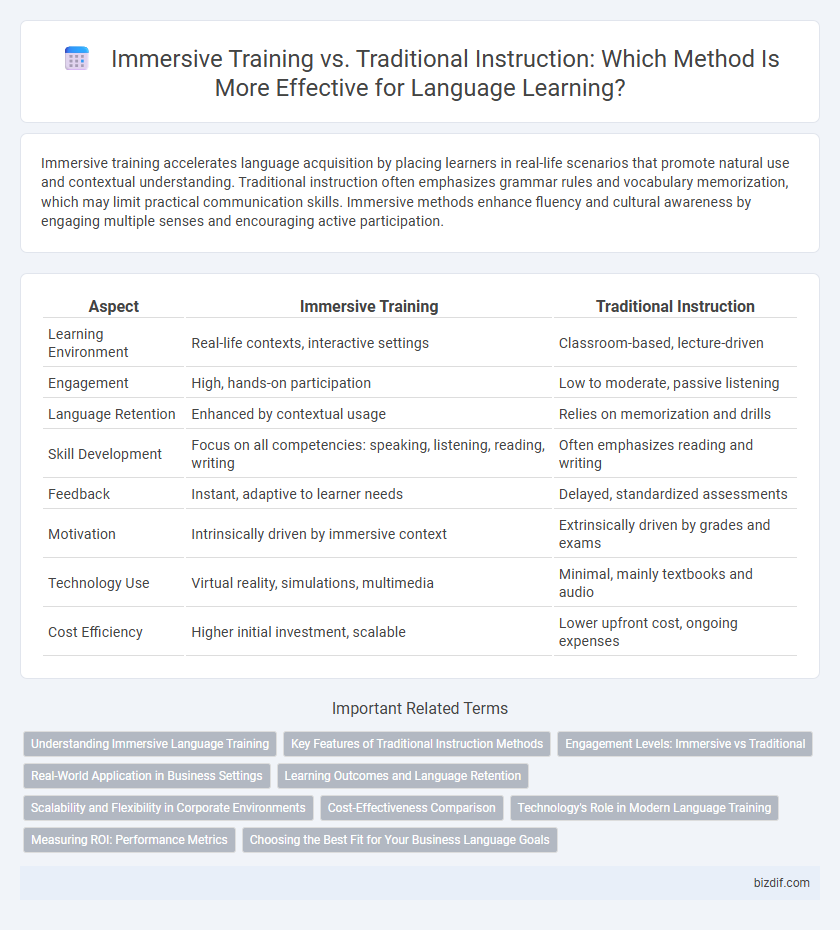Immersive training accelerates language acquisition by placing learners in real-life scenarios that promote natural use and contextual understanding. Traditional instruction often emphasizes grammar rules and vocabulary memorization, which may limit practical communication skills. Immersive methods enhance fluency and cultural awareness by engaging multiple senses and encouraging active participation.
Table of Comparison
| Aspect | Immersive Training | Traditional Instruction |
|---|---|---|
| Learning Environment | Real-life contexts, interactive settings | Classroom-based, lecture-driven |
| Engagement | High, hands-on participation | Low to moderate, passive listening |
| Language Retention | Enhanced by contextual usage | Relies on memorization and drills |
| Skill Development | Focus on all competencies: speaking, listening, reading, writing | Often emphasizes reading and writing |
| Feedback | Instant, adaptive to learner needs | Delayed, standardized assessments |
| Motivation | Intrinsically driven by immersive context | Extrinsically driven by grades and exams |
| Technology Use | Virtual reality, simulations, multimedia | Minimal, mainly textbooks and audio |
| Cost Efficiency | Higher initial investment, scalable | Lower upfront cost, ongoing expenses |
Understanding Immersive Language Training
Immersive language training provides learners with real-life conversational practice and cultural context, enhancing language retention and fluency. This method leverages virtual reality, interactive simulations, and situational role-playing to mimic authentic environments, contrasting with traditional instruction's reliance on textbooks and rote memorization. Research shows immersive training boosts engagement and accelerates comprehension by fostering active participation and contextual learning.
Key Features of Traditional Instruction Methods
Traditional instruction methods emphasize structured lesson plans, teacher-led discussions, and standardized assessments to track student progress. These approaches rely heavily on textbooks, lectures, and repetitive practice to reinforce language rules and vocabulary. Classroom interactions primarily involve direct teacher guidance with limited real-world conversational practice.
Engagement Levels: Immersive vs Traditional
Immersive training significantly boosts engagement levels by utilizing virtual reality and interactive simulations, creating hands-on experiences that captivate learners. Traditional instruction often relies on passive listening and memorization, leading to lower retention and reduced motivation. Studies reveal immersive methods can increase learner engagement by up to 60% compared to conventional classroom settings.
Real-World Application in Business Settings
Immersive training in language instruction significantly enhances real-world application by simulating authentic business scenarios, enabling learners to practice industry-specific communication more effectively than traditional instruction. This method increases retention and fluency through interactive role-playing, virtual meetings, and problem-solving exercises that mirror actual workplace challenges. Traditional instruction often lacks this contextual depth, limiting learners' ability to transfer language skills confidently to dynamic business environments.
Learning Outcomes and Language Retention
Immersive training significantly enhances language retention by simulating real-life contexts that promote active engagement and practical application, resulting in higher speaking fluency and comprehension compared to traditional instruction. Studies indicate that learners in immersive environments demonstrate increased vocabulary recall and long-term retention due to continuous exposure and contextual learning. Traditional instruction often relies on rote memorization and passive learning, which can lead to lower retention rates and slower development of conversational skills.
Scalability and Flexibility in Corporate Environments
Immersive training leverages virtual reality and interactive simulations, offering scalable solutions that adapt to varying employee numbers without significant additional costs. Traditional instruction often requires fixed schedules and physical presence, limiting flexibility and expansion in dynamic corporate settings. Companies benefit from immersive approaches by easily customizing content and accommodating diverse learning paces across global teams.
Cost-Effectiveness Comparison
Immersive training leverages virtual reality and interactive simulations, often requiring higher upfront investment but resulting in faster learner proficiency and reduced long-term costs. Traditional instruction relies on classroom settings and printed materials with lower initial expenses but may lead to longer training durations and higher accumulated costs. Studies indicate immersive methods deliver greater cost-efficiency by minimizing absenteeism and enhancing knowledge retention despite the initial technology expenses.
Technology's Role in Modern Language Training
Technology revolutionizes modern language training by enabling immersive experiences through virtual reality and AI-powered language apps, which enhance real-time interaction and contextual learning. Traditional instruction relies heavily on textbooks and classroom settings, whereas immersive training leverages digital tools to simulate natural conversations and cultural environments. This integration of technology optimizes language retention and accelerates fluency by providing adaptive feedback and personalized learning pathways.
Measuring ROI: Performance Metrics
Immersive training demonstrates higher ROI through improved knowledge retention rates, often exceeding 75%, compared to traditional instruction's average of 50-60%. Performance metrics such as task completion speed, error reduction, and learner engagement levels consistently show gains of 20-30% with immersive methods. These data points highlight a quantifiable advantage in skill mastery and operational efficiency when measuring training effectiveness.
Choosing the Best Fit for Your Business Language Goals
Immersive training offers experiential learning through real-life scenarios, enhancing language retention and practical communication skills essential for business success. Traditional instruction, characterized by structured lessons and grammar-focused teaching, suits learners needing foundational knowledge and formal language proficiency. Selecting the best fit depends on your business goals--whether prioritizing immediate conversational fluency or comprehensive language mastery for long-term growth.
Immersive Training vs Traditional Instruction Infographic

 bizdif.com
bizdif.com